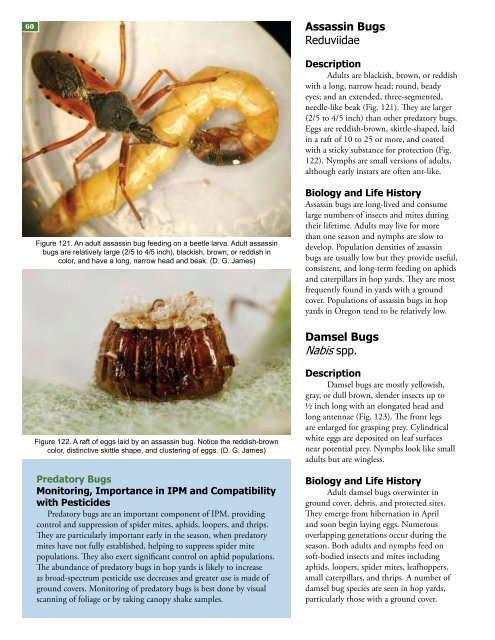Field Guide for Integrated Pest Management in Hops
Field Guide for Integrated Pest Management in Hops
Field Guide for Integrated Pest Management in Hops
You also want an ePaper? Increase the reach of your titles
YUMPU automatically turns print PDFs into web optimized ePapers that Google loves.
60Assass<strong>in</strong> BugsReduviidaeDescriptionAdults are blackish, brown, or reddishwith a long, narrow head; round, beadyeyes; and an extended, three-segmented,needle-like beak (Fig. 121). They are larger(2/5 to 4/5 <strong>in</strong>ch) than other predatory bugs.Eggs are reddish-brown, skittle-shaped, laid<strong>in</strong> a raft of 10 to 25 or more, and coatedwith a sticky substance <strong>for</strong> protection (Fig.122). Nymphs are small versions of adults,although early <strong>in</strong>stars are often ant-like.Figure 121. An adult assass<strong>in</strong> bug feed<strong>in</strong>g on a beetle larva. Adult assass<strong>in</strong>bugs are relatively large (2/5 to 4/5 <strong>in</strong>ch), blackish, brown, or reddish <strong>in</strong>color, and have a long, narrow head and beak. (D. G. James)Biology and Life HistoryAssass<strong>in</strong> bugs are long-lived and consumelarge numbers of <strong>in</strong>sects and mites dur<strong>in</strong>gtheir lifetime. Adults may live <strong>for</strong> morethan one season and nymphs are slow todevelop. Population densities of assass<strong>in</strong>bugs are usually low but they provide useful,consistent, and long-term feed<strong>in</strong>g on aphidsand caterpillars <strong>in</strong> hop yards. They are mostfrequently found <strong>in</strong> yards with a groundcover. Populations of assass<strong>in</strong> bugs <strong>in</strong> hopyards <strong>in</strong> Oregon tend to be relatively low.Damsel BugsNabis spp.Figure 122. A raft of eggs laid by an assass<strong>in</strong> bug. Notice the reddish-browncolor, dist<strong>in</strong>ctive skittle shape, and cluster<strong>in</strong>g of eggs. (D. G. James)Predatory BugsMonitor<strong>in</strong>g, Importance <strong>in</strong> IPM and Compatibilitywith <strong>Pest</strong>icidesPredatory bugs are an important component of IPM, provid<strong>in</strong>gcontrol and suppression of spider mites, aphids, loopers, and thrips.They are particularly important early <strong>in</strong> the season, when predatorymites have not fully established, help<strong>in</strong>g to suppress spider mitepopulations. They also exert significant control on aphid populations.The abundance of predatory bugs <strong>in</strong> hop yards is likely to <strong>in</strong>creaseas broad-spectrum pesticide use decreases and greater use is made ofground covers. Monitor<strong>in</strong>g of predatory bugs is best done by visualscann<strong>in</strong>g of foliage or by tak<strong>in</strong>g canopy shake samples.DescriptionDamsel bugs are mostly yellowish,gray, or dull brown, slender <strong>in</strong>sects up to½ <strong>in</strong>ch long with an elongated head andlong antennae (Fig. 123). The front legsare enlarged <strong>for</strong> grasp<strong>in</strong>g prey. Cyl<strong>in</strong>dricalwhite eggs are deposited on leaf surfacesnear potential prey. Nymphs look like smalladults but are w<strong>in</strong>gless.Biology and Life HistoryAdult damsel bugs overw<strong>in</strong>ter <strong>in</strong>ground cover, debris, and protected sites.They emerge from hibernation <strong>in</strong> Apriland soon beg<strong>in</strong> lay<strong>in</strong>g eggs. Numerousoverlapp<strong>in</strong>g generations occur dur<strong>in</strong>g theseason. Both adults and nymphs feed onsoft-bodied <strong>in</strong>sects and mites <strong>in</strong>clud<strong>in</strong>gaphids, loopers, spider mites, leafhoppers,small caterpillars, and thrips. A number ofdamsel bug species are seen <strong>in</strong> hop yards,particularly those with a ground cover.








